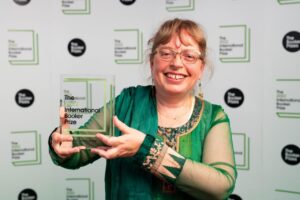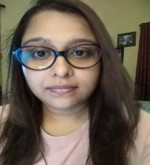INTERVIEWED BY RITUPARNA MUKHERJEE
Daisy Rockwell is an acclaimed name in the world of literary translation, especially following the 2022 International Booker Prize for translating Geetanjali Shree’s Tomb of Sand. She has been one of the champions of Hindi and Urdu literature, especially those set in and around the early twentieth century and during the Partition of the Indian subcontinent. She has translated stalwarts of Hindi and Urdu literature such as Upendranath Ashk, Bhisham Sahni, Khadija Mastur, Krishna Sobti and most recently, Geetanjali Shree and Usha Priyamvada. Most importantly, her efforts at translating women’s writings in these two languages and bringing them to an international readership, remains commendable. She has been awarded the Warwick Prize for Women in Translation in 2022 and Distinguished Translator Award at the Jaipur Literary Fest in 2023 by Vani Foundation and Teamwork Arts. The Antonym Magazine’s Rituparna Mukherjee interviewed the prolific translator on the nature of her craft as well as her points of view on translation.
RM: Your foray into Hindi and Urdu literature came quite early in your career. What interested you in Hindi and Urdu literature, especially with your knowledge of German, French, Latin and Greek?
DR: It was a new world of stories and styles for me. I found that extremely exciting.
RM: Although you have been working in translation for quite some time, you have gained popularity in the literary and translation circuits with the International Booker Prize in 2022 for the translation of Geetanjali Shree’s Tomb of Sand. Congratulations on finishing such a monumental work and this prestigious award. How challenging was it for you to translate such a voluminous work?
DR: It was the hardest book I’ve ever translated. Maybe the hardest thing I’ve ever done.
RM: You have also importantly translated Krishna Sobti, Khadija Mastur and Upendranath Ashk, all of whose works are spatio-temporally placed just before or around the partition era. What about these authors, their oeuvre and especially the historical moment of partition stands meaningful to you?
DR: How can you explain why you are drawn to a particular era? I don’t know why, but that is the era and the place for me. I have translated numerous works set in Lahore, from the 1930s to the 1950s. I feel like I’m coming home when a character steps down from the station in Lahore and it’s 1935. I have visited Lahore only twice in my life, but both times I felt that I was home. Past life?
RM: How important would you consider fluency in the source language- in your case Hindi and Urdu- in aiding the process of translation?
DR: Some translators are able to work without fluency, but I consider it a must.
RM: How do you familiarize yourself with a work’s cultural and geographical location and its peculiarities? How significant is that knowledge for you as a translator?
DR: All such things are of vital importance. A translator needs to be able to visualize, hear and understand exactly what is going on. To translate Ashk, I visited the old city in Jalandhar and his family home. I also traveled to Shimla to gain an understanding of a lengthy section of In the City a Mirror Wandering that takes place there. I also ask people questions all the time—many things that are described in books from the mid-twentieth century are no longer in practice in contemporary India, so I need to find people who have specialized knowledge, or their grandparents!
RM: Could you describe your own process of translating a literary text? At which stage in your own process do you bring in the author for consultation and clarification?
DR: Most of the authors I’ve translated have been very elderly or are no longer with us, so I haven’t consulted at all. Geetanjali Shree was the first author I had translated whom I was able to consult extensively. I asked her numerous questions after the third draft, and then she read maybe the sixth or seventh draft and made corrections, and we had extensive dialogue over that draft. I don’t think that Tomb of Sand could easily have been translated without the availability of the author because her use of language is idiosyncratic. Only she knows the answer to many questions about the work.
RM: Which aspect of the translation process would you consider most difficult?
DR: Every stage is difficult! Even “easy” books have their difficult moments. The first draft is always the most time-consuming part, and in that sense, it’s the most difficult, because you are slogging away, all alone, for months, or even years! When the book starts to take shape in English, after a few drafts, that’s the exciting part.
RM: How do you make translations of Hindi and Urdu literature relatable to an international audience? What is your view on keeping certain regionalisms while translating and publishing for an international audience? Do you think it somewhat mitigates the insular hegemony of the English language?
DR: I have an elaborate set of rules developed over time for how and when and why I choose to retain certain words from the original text. It’s a common practice to just leave certain common words in the original in Indian translations, but I don’t do that. I want to teach the international audience certain words, but those words are carefully selected. I want to draw them in and stretch English to fit the text, but I don’t want to overwhelm the readers with new vocabulary. It’s a delicate dance.
RM: You have said that in 2016 you decided to read and translate mainly women’s work. What moved to you to that decision and how has it affected the way you read a text thereafter?
DR: I was initially moved by some aha moments of translating and reading, where I noticed how women’s experiences were being completely ignored by male authors. I also looked at my published translations and realized with some shame that they were all books by male authors. I decided to even the score, as it were, but now I doubt I will go back. Women writers have so much to offer us and I want to be a part of that process of offering.
RM: Which works of translation have excited you thus far? And since you are also a writer, and have published the novel Taste in 2014, do you feel that translation helps your own writing?
DR: I like to think that translation IS my own writing, but it is true that there are ways in which translation writing is more difficult than non-translation writing, because you are called upon to create the most outrageous sentences. I feel sometimes like there are too few guardrails up when I’m doing non-translation writing. I love the discipline of it.
RM: What current projects are you working on and what translations can we look forward to from you in the near future?
DR: I am translating Geetanjali’s 1998 novel, Hamara Shahar Us Baras (Our City, That Year), which is set in a city much like Surat, during communal riots, much like what occurred following the demolition of the Babri Masjid. Also, a short story collection of hers: Yahan Haathi Rehte The (Once Elephants Lived Here). And I’m working on two Urdu projects: Nagari Nagari Phira Musafir (for which I haven’t come up with the perfect title yet!), a 1955 novel by Nisar Aziz Butt (1927-2020) about a highly intellectual young Pathan woman. I like to say it’s Middlemarch meets Magic Mountain in the Northwest Frontier Provinces. The other is the horror and romance writings of Hijab Imtiaz Ali (1908-1999). I’ve translated some of her horror short stories so far and I love her so much! And then I just ‘might’ be working on a memoirish sort of thing on translation.
RM: You have mentioned that a translation seminar with A.K. Ramanujan early in your career has been helpful for you. How would you advise young translators to navigate the world of translating and then publishing?
DR: It’s not an easy path, and I would advise young translators to seek out mentors, either through formal mentorship programs, or informally. I have one official mentee and numerous unofficial ones. I believe in translator solidarity and paying it forward. The translator community is by and large immensely caring and helpful. Make yourself a part of the community and get advice about everything you need to know. And remember the following three things: 1. A translation is a work written in the target language. An English translation is a work written in English, and it must work as an independent entity. It can’t carry the original text around on its back. 2. Young translators are always shocked when I tell them that they should complete at least ten drafts of their translation. Many people feel that three is quite enough. Three is only the beginning! Do more. 3. Rights: make sure you have written permission from the rights holder(s) of your text to translate. Do not rely on word of mouth. Do not assume it will all get sorted out somehow. Sixty-five years after the death of the author, the rights come into public domain. If you want to avoid rights hassles, find yourself someone out of copyright!
Also, read Forgetting is Not Really A Decision by Jaishree Roy, translated from The Hindi by Rituparna Mukherjee and published in The Antonym.
Follow The Antonym’s Facebook page and Instagram account for more content and exciting updates.



























This interview of Daisy Rockwell is interesting, enriching and insightful. The questions asked were well thought and the answers thought provoking. Thank you Rituparna Mukherjee interviewing Rockwell. A must read for all aspiring translators.